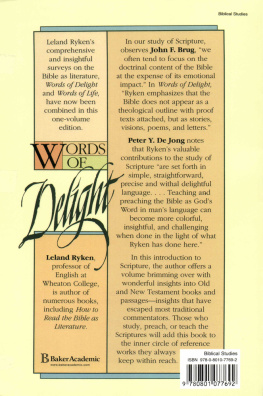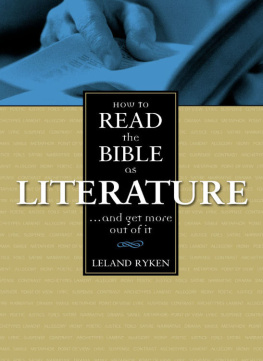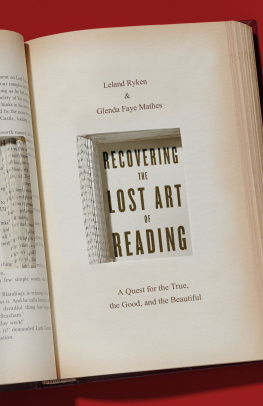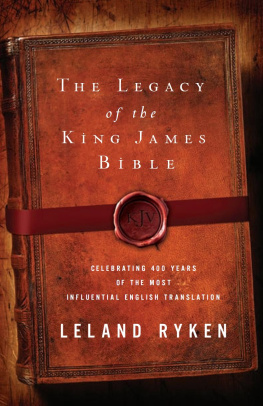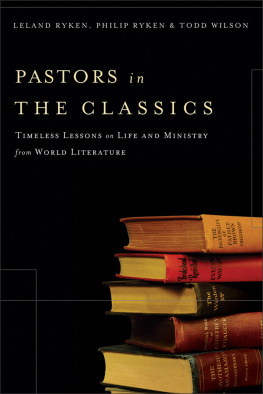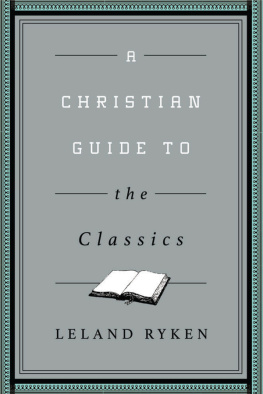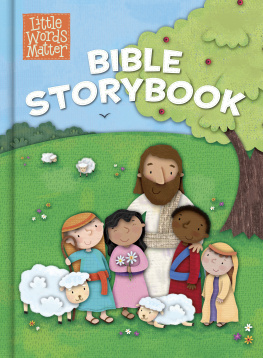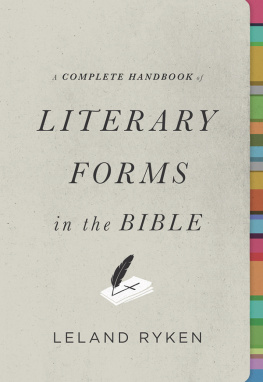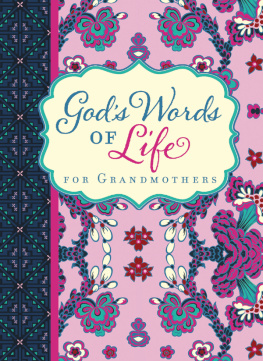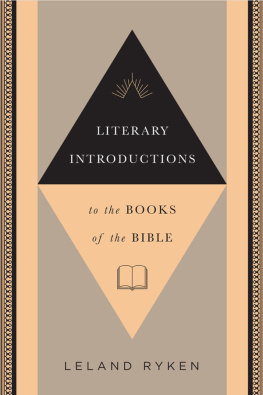Leland Ryken - Words of Delight: A Literary Introduction to the Bible
Here you can read online Leland Ryken - Words of Delight: A Literary Introduction to the Bible full text of the book (entire story) in english for free. Download pdf and epub, get meaning, cover and reviews about this ebook. year: 1993, publisher: Baker Publishing Group, genre: Religion. Description of the work, (preface) as well as reviews are available. Best literature library LitArk.com created for fans of good reading and offers a wide selection of genres:
Romance novel
Science fiction
Adventure
Detective
Science
History
Home and family
Prose
Art
Politics
Computer
Non-fiction
Religion
Business
Children
Humor
Choose a favorite category and find really read worthwhile books. Enjoy immersion in the world of imagination, feel the emotions of the characters or learn something new for yourself, make an fascinating discovery.
- Book:Words of Delight: A Literary Introduction to the Bible
- Author:
- Publisher:Baker Publishing Group
- Genre:
- Year:1993
- Rating:3 / 5
- Favourites:Add to favourites
- Your mark:
- 60
- 1
- 2
- 3
- 4
- 5
Words of Delight: A Literary Introduction to the Bible: summary, description and annotation
We offer to read an annotation, description, summary or preface (depends on what the author of the book "Words of Delight: A Literary Introduction to the Bible" wrote himself). If you haven't found the necessary information about the book — write in the comments, we will try to find it.
Words of Delight: A Literary Introduction to the Bible — read online for free the complete book (whole text) full work
Below is the text of the book, divided by pages. System saving the place of the last page read, allows you to conveniently read the book "Words of Delight: A Literary Introduction to the Bible" online for free, without having to search again every time where you left off. Put a bookmark, and you can go to the page where you finished reading at any time.
Font size:
Interval:
Bookmark:
W ORDS OF D ELIGHT
A Literary Introduction to the Bible
Second Edition
Leland Ryken
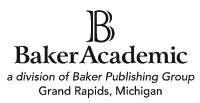
1992 by Leland Ryken
Published by Baker Academic
a division of Baker Publishing Group
P.O. Box 6287, Grand Rapids, MI 49516-6287
www.bakeracademic.com
Originally published as Words of Delight and Words of Life , 1987 by Baker Book House
Ebook edition created 2012
All rights reserved. No part of this publication may be reproduced, stored in a retrieval system, or transmitted in any form or by any meanselectronic, mechanical, photocopy, recording, or any otherwithout the prior written permission of the publisher. The only exception is brief quotations in printed reviews.
ISBN 978-1-5855-8063-7
Library of Congress Cataloging-in-Publication Data is on file at the Library of Congress, Washington, DC.
Unless otherwise indicated, Scripture quotations are from the Revised Standard Version of the Bible, copyright 1952 [2nd edition, 1971] by the Division of Christian Education of the National Council of Churches of Christ in the United States of America. Used by permission. All rights reserved.
Scripture quotations labeled KJV are from the King James Version of the Bible.
Scripture quotations labeled NASB are from the New American Standard Bible, Copyright 1960, 1962, 1963, 1968, 1971, 1972, 1973, 1975, 1977, 1995 by The Lockman Foundation. Used by permission.
Contents
Preface
This is a book of literary criticism on the Bible. Its format is simple: it combines theoretic comments about various literary aspects of the Bible, accompanied by explications of selected texts to illustrate the theory. My intention is that this combination of theory and illustration will provide my readers with a methodology that they can apply to other biblical texts as well.
This revised edition of Words of Delight incorporates into it a volume that was originally a separate book Words of Life: A Literary Introduction to the New Testament . The literary approach that I develop in this combined volume parallels that in my book How to Read the Bible as Literature (Zondervan, 1984), but this book contains actual explications of texts lacking in the other book.
My footnotes constitute my list of sources that I think readers would most benefit from consulting. A glossary of literary terms appears at the end of the book.
Wheaton College
August 1992
Introduction
Reading the Bible as Literature
T here was a man who had two sons.
The Lord is my shepherd.
Behold, a great red dragon, with seven heads and ten horns.
If these excerpts were the only information that we had about the Bible, they would be enough to dispel a common misconception. Because the Bible is a book with religious authority, we tend to assume that it is a theology book. But if we look at how the Bible presents its material, it resembles a literary work more than anything else. It is filled with stories, poems, visions, and letters. The thing that it is emphatically not is what we so often picture it as beinga theological outline with proof texts attached.
To say that the Bible is a very literary book should not be controversial. The approaches of biblical scholars are becoming more literary with every passing year. An expository sermon on a biblical passage has more in common with a literary approach to the Bible than with traditional methods of biblical scholarship. The purpose of this introduction is to explore what it means to approach the Bible as literature.
What Kind of Book Is the Bible?
The Bible is unique. Part of its uniqueness is the combination of material that we find in it. Three types of writing predominate and are intermingled throughout the Bible. I will call them theological or moral exposition, history, and literature.
The Three Types of Writing in the Bible
By theological exposition I mean this type of material:
But God, who is rich in mercy, out of the great love with which he loved us, even when we were dead through our trespasses, made us alive together with Christ (by grace you have been saved), and raised us up with him, and made us sit with him in the heavenly places in Christ Jesus.... For by grace you have been saved through faith. [Eph. 2:48]
The leading features of such writing are obvious. The governing purpose is to convey theological or moral information. Such writing is strongly conceptual, and the vocabulary tends toward abstraction with such words as love, mercy, grace , and faith . The basic strategy is to tell us about the subject, not (as in literature) to recreate an experience. It appeals to our intellectual grasp of prepositional truth.
A second type of writing in the Bible is historical. It shares with theological writing the impulse to convey information. Here is a specimen:
In the thirty-eighth year of Asa king of Judah, Ahab the son of Omri began to reign over Israel.... And Ahab the son of Omri did evil in the sight of the L ORD more than all that were before him.... He erected an altar for Baal in the house of Baal, which he built in Samaria.... Ahab did more to provoke the L ORD , the God of Israel, to anger than all the kings of Israel who were before him. [1 Kings 16:2933]
Such writing is governed by the documentary impulse to record the facts of the matter. Like the previous selection, it is expository or informational writing. Writing like this aims to tell us what happened and does not share the preoccupation of literature to tell us what happens universally. Historical writing in the Bible does not tell only the facts of the matter, however. It obviously puts the historical facts into an interpretive moral and spiritual framework in which, for example, the writer does not hesitate to align himself against Ahab.
The third dominant type of writing in the Bible is literature. Here is an example:
Now the serpent was more subtle than any other wild creature that the L ORD God had made. He said to the woman, Did God say, You shall not eat of any tree of the garden? And the woman said to the serpent, We may eat of the fruit of the trees of the garden; but God said, You shall not eat of the fruit of the tree which is in the midst of the garden, neither shall you touch it, lest you die. But the serpent said to the woman, You will not die. For God knows that when you eat of it your eyes will be opened, and you will be like God, knowing good and evil. So when the woman saw that the tree was good for food, and that it was a delight to the eyes, and that the tree was to be desired to make one wise, she took of its fruit and ate; and she also gave some to her husband, and he ate. Then the eyes of both were opened, and they knew that they were naked; and they sewed fig leaves together and made themselves aprons. [Gen. 3:17]
The passage appeals primarily to our imagination (our image-making and image-perceiving capacity). The governing purpose is to recreate the actual scene and event in sufficient detail that we can imaginatively experience them. The writer even quotes the very speeches of the characters, and nothing can be more actual and concrete than that.
The writers chief aim in this passage is to tell a story, not to develop a theological argument. Whereas expository writing gives us the precept, literature incarnates the precept in an examplean example that does not simply illustrate the truth but is itself the meaning. A work of literature is incarnationalit embodies meaning. The customary literary terminology for talking about this is to say that the writer of literature shows rather than tells.
The story of the fall illustrates this distinction particularly well. The writer tells us that the serpent was subtle. The subsequent action shows us that subdety. Several things are subde about the serpents opening question, Did God say, You shall not eat of any tree of the garden? Even to state it as a question implies incredulity over a command by God that is made to appear unreasonable and arbitrary. The serpent also subtly amplifies the prohibition by speaking of how God has said that Adam and Eve cannot eat of any tree of the garden. The cleverness of the serpent is further demonstrated in verses 4 and 5, where he adopts a more aggressive stance by directly contradicting God, by giving Eve a motivation for eating the fruit, by cloaking his evil intention as benevolent concern for Eve, and by instilling in Eve the false belief that she can eat the forbidden fruit with impunity.
Next pageFont size:
Interval:
Bookmark:
Similar books «Words of Delight: A Literary Introduction to the Bible»
Look at similar books to Words of Delight: A Literary Introduction to the Bible. We have selected literature similar in name and meaning in the hope of providing readers with more options to find new, interesting, not yet read works.
Discussion, reviews of the book Words of Delight: A Literary Introduction to the Bible and just readers' own opinions. Leave your comments, write what you think about the work, its meaning or the main characters. Specify what exactly you liked and what you didn't like, and why you think so.

